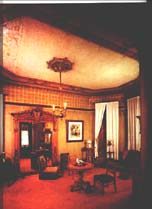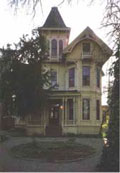|
History
of the House
The
Family:
The house was built in 1882-1883 by Julia Moses and Watson A.
Bray, for their daughter,
Emma, upon her marriage to Alfred H. Cohen, attorney, on February 28,
1884, the son of Emilie Gibbons and A. A. Cohen, the latter
also a lawyer. Both families were socially prominent and well-to-do.
Watson Bray was a successful commodities broker while A. A. Cohen had in
1863 established the first railroad and ferry system in Alameda County
and also served as chief attorney for the Central Pacific Railroad.
The Brays bought the land and built the house for the couple
(cost of construction, $10,000); the senior Cohen's completely furnished
it ahead of time, allowing the bride and groom to move in on their
wedding day after a lavish ceremony at Oak Tree Farm, the Bray mansion
[now destroyed] that once stood directly across the street from The
Cohen-Bray House.
A
Noteworthy Structure, Then and Now:
The
property, listed in the National Register of Historic Places since 1975,
is an Oakland landmark and unique for a number of reasons.
It typifies the Stick style of architecture of the 1880�s and
still contains many examples of its original furnishings in the
Aesthetic style of Charles Eastlake.
The original interior decoration of the house also remains - a
quintessential example of the Anglo-Japanese design craze that so caught
the fancy of both American and British tastes in the 1880�s.
This interior, its most distinguished aspect originally, is all
the more remarkable today for having survived intact into the 21st
Century.

Time
Has Stood Still at The Cohen-Bray House: Bill
O�Brien of the East Bay Express noted in a 1999 article:
�In the
115 years since the elegant Victorian at 1440 29th Avenue was
built as a wedding gift�the neighborhood has changed considerably.
Gone are the grand estates that graced the �Fruit Vale�
district back in 1884, replaced by the squat stucco bungalows and
featureless apartment buildings typical of lower
middle-class Oakland.
Orchards filled with the cherry and apple trees that gave the
neighborhood its name have disappeared as well, supplanted by the auto
dealers, thrift shops, and restaurants that now line busy International
Boulevard.
But even though the
newlyweds�wouldn�t be able to recognize the world outside their
front window today, they�d have no trouble navigating around the
interior of the house. In
the parlor, where they often entertained guests, they could sit on the
same chairs, still in their original places on the same rug.
They could pour tea into cups they received as wedding presents,
still stored in the elaborately carved �tag�re transported around Cape
Horn for their nuptials. The
paintings on the wall, the long dining room table, the books in the
library all would have an unmistakably familiar look. In the front hallway, they could consult the grandfather
clock that has been keeping time there since Chester Arthur was
President.�
Visitors standing today in its halls, parlors, and bedrooms can see a
period home with original wallpaper, woodwork, accessories, even heat
sources [fireplaces only] as they were for the honeymooners in 1884.
This is due in large part to the fact that the house has never been sold
out of the family, and descendents of the couple continue to live in the
house today. Hence The
Cohen-Bray House offers a unique chance to glimpse first hand the life
of a house and its family from a century ago, a life that has stretched
unbroken through the generations to the present moment.
�Old buildings are not ours.
They belong partly to those who built them, and partly to the
generations of mankind who are to follow us.
The dead still have their right to them; that which they
labored for we have no right to obliterate.
What we ourselves have built, we are at liberty to throw down.
But what other men gave their strength and wealth and life to
accomplish, their right over it does not pass away with their
death.� �John
Ruskin
Link
here to web site with historic furniture -in the news.
|
